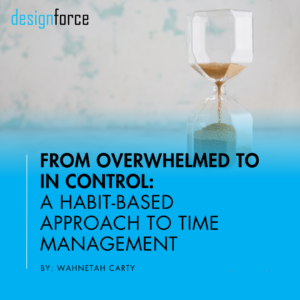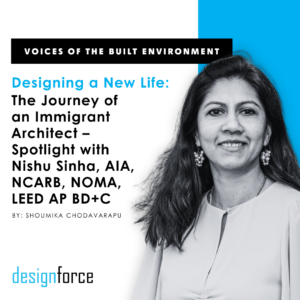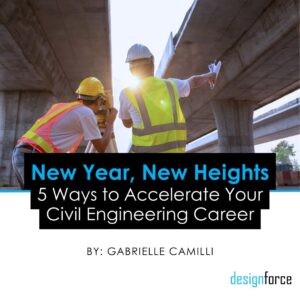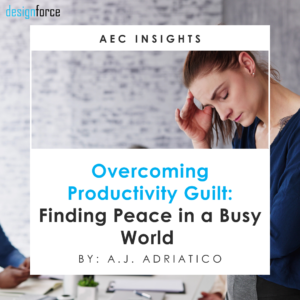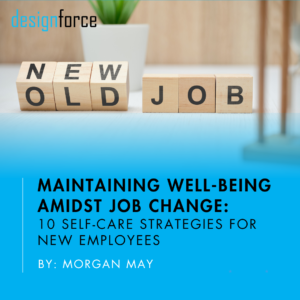By: Shoumika Chodavarapu, MS
Immigrating to a new country is both terrifying and exhausting. The experience of navigating an unfamiliar country – its customs, expectations and professional landscape – is nothing short of humbling and eye-opening. When I returned to the U.S after a decade abroad, I felt like a stranger in what was supposed to be called home. The process gave me a deep appreciation for the resilience of immigrants who build careers in new environments, often overcoming challenges that go unseen. Despite residing in a country with an immigrant population of 14.3%, many of our stories seem to feel unique and singular. However, that is far from the truth.
I recently had the pleasure of sitting down and speaking with Nishu Sinha, Senior Project Architect, who has overcome many trials and tribulations to get to where she is today. As a current AIA member, she is an active advocate for immigrants within the architecture field, promoting inclusive design practices for underrepresented professionals. Our conversation shed light on the realities of being an immigrant in architecture – the struggles, resilience and the potential new reality in this country for immigrant architects.
How was your experience in the architecture field as an immigrant? Tell us about your journey into becoming a Senior Project Architect today along with specific challenges you faced early on in your career.
I began my journey in a small town in India called Patna with the goal of becoming an engineer, although that didn’t happen. Architecture was never on my radar. My path changed when I was denied admission to a local engineering college in Mumbai, and with my uncle’s advice I decided to pursue architecture. I felt more of a culture shock moving from Patna to Mumbai, as I was an outsider moving to a metropolitan city. Despite coming from a non-architectural background, I excelled in a 5-year program at the University of Mumbai, graduating as a gold medalist. I was surprised as I wasn’t initially interested in pursuing architecture, but as time went on and I traveled more, I started to become more interested.
Soon after finishing my bachelor’s degree, I landed a job at a firm in Mumbai. Most of my colleagues had plans to continue pursuing their education abroad, which had me intrigued. I was still craving more opportunities than what I was receiving at the firm I worked at. After speaking with my colleagues and my mentor, I decided to take the step to pursue a Master’s in the U.S. I had to go to internet cafés to research which colleges to apply to and take the advice of those who had applied. I ended up at the University of Buffalo, with only a few hundred dollars and a student loan, as they had offered me a scholarship. At Buffalo, I took many odd jobs such as working in the residence hall and cutting pizza, until I was finally able to secure a graduate assistantship in the Urban Design Department.
As far as challenges go, adapting to the U.S was more of a climate shock than culture shock. Mumbai was more of a hustle and bustle city while Buffalo was very quiet. The U.S professional landscape posed significant challenges as well. Architectural practices, codes, and client expectations were quite different from what I had experienced in India. One vivid memory from my early days was when my project manager assigned me the task of creating a section of the plenum, which involved sprinklers – a system I had never encountered before. This was a steep learning curve for me. Furthermore, the licensing process required me to pass multiple exams while balancing both work and personal life. Without this certification, I was unable to officially hold the title of Project Architect, despite already performing those duties on several projects. I started applying for jobs three to four months before I even graduated, to ensure I secured a job as I needed a job to remain in the States. Moreover, during this time I was grateful to have the mentorship of Esther Simon. She was my Project Manager at the first company I joined in the U.S and continued to mentor me after she left the company.
What does DEI mean to you, and how has it shaped your career or personal experiences?
The term “DEI” is new. Maybe about six or seven years ago was when firms started using this terminology – no one was formally talking about it. To me, it’s creating a space where everyone feels empowered and valued, especially underrepresented individuals. In my journey, I lacked champions that would advocate for me which in turn affected my professional growth. I am glad there is a lot of awareness now. Nearly 15 years ago, I had to prove myself and work even harder. As an immigrant, everything becomes secondary to you. You have to make sure you take care of your visa process and are on top of that. Once I received more stability, I was able to think about things like leadership, bonuses and professional development. DEI has shaped my career by motivating me to mentor, collaborate, and design spaces for all communities. Whether I’m co-authoring a handbook for immigrant architects or volunteering in community initiatives, I strive to champion inclusivity and create equitable, enriching experiences for everyone.
How can associations play a bigger part in advocating for DEI, in addition to organizations?
Associations can advocate for DEI by creating inclusive policies, offering educational resources, and amplifying underrepresented voices. This includes beginning to advocate for those in junior positions rather than just leadership positions. Organize events where individuals from underrepresented communities can share their stories as well as advocate for not only mission and goals, but what is being done on a day-to-day basis.
You were a huge part in the AIA Events Immigrant Architect Series and are currently a contributor for the Immigrant Architects Coalition. Do you mind sharing a bit about your experience and how you came to be a part of this organization?
After receiving my license, I was able to finally focus on giving back to the community. In 2019, I attended an AIA event, where I was invited by Yiselle Santos Rivera. Through that event, I began my involvement with AIA DC. This led me to co-create the Immigrant Architect Series in collaboration with three AIA DC committees, aiming to support immigrant architects in overcoming educational, financial, and cultural barriers. I hosted a session called, “Your Path to a Strong Foundation,” focusing on legal options and advocating for immigration reform. The three-part series provided valuable resources and insights from industry leaders, attorneys, and HR professionals.
DEI continues to be a discussion within the AEC industry, and getting leadership and top management buy in is critical for the success of DEI initiatives within an organization. In your opinion, how can individuals champion efforts to ensure that DEI is advocated in their organization?
Individuals can champion DEI by leading with empathy, advocating for inclusivity, and creating safe spaces for diverse perspectives. It is important to recognize that you do not have to take away from your project hours to give back to the community. Firms can create systems to be able to bill volunteering hours to their committees to incentivize individuals to give back and volunteer. Firms can establish connections with Black, Indigenous and People of Color (BIPOC) connections or Equity groups to provide a platform for individuals to share experiences and foster growth. With this implementation, it is important for firms to track and encourage employee participation. Additionally, by offering mentorship, promoting diverse talents, and holding leadership accountable, individuals can drive DEI initiatives. Consistently modeling inclusive behavior and prioritizing DEI in daily actions will help ensure it becomes a core value in the organization.
Naturally, it is a daunting process to move to a completely new country with no connections – what is your advice to young architectural professionals or even tenured architects that are looking to make the move to the U.S and navigate an unknown landscape?
Everyone believes it is overwhelming, and it is, whether you are just starting or have years of experience. It is important to remember that it will take time. Everyone is on their own journey, so do not compare yourself to others. You are coming to a different country on your own and you’ve already won by coming outside of your comfort zone! My advice is to actively seek connections through networking, attend industry events, and find mentors who can guide you. Identify someone within the firm who can support and champion your growth. It may feel like you are alone, but you are not.
Lastly, can you share some of your thoughts on the recent news and press from the new administration in the U.S and how this will affect the industry?
The industry will most definitely be affected by the immigration laws. For example, there will be a decreasing workforce as students and professionals wanting to move here will be impacted. No one wants to live in uncertainty. In all honesty, in architecture we never thought that we could work from home – however, we did, and we survived that. Technology has made it possible. Additionally, this will create a domino effect with less international students applying to universities leading to less individuals applying to the workforce. This will lead to a need to increase and encourage U.S citizens to study and apply to the AEC industry. There will be a need to shift gears and start thinking critically about the future of the industry.
Final Thoughts
In addition to learning a lot, I felt a lot of comfort in my conversation with Nishu. Despite going through many challenges and facing adversity, she never failed to advocate and give back to her community. Her work with AIA and advocating for the immigrant community is especially important in the current climate of the country. I encourage everyone to think about how you can impact your community and advocate for those around you. Be a mentor, offer advice and insight and champion those that are historically underrepresented. We are only stronger with the inclusion of a diverse workforce representing the various backgrounds we come from. If you are an AEC professional and want to chat about career, goal setting or taking the next step professionally, please reach out to me at sc@designforce.me!
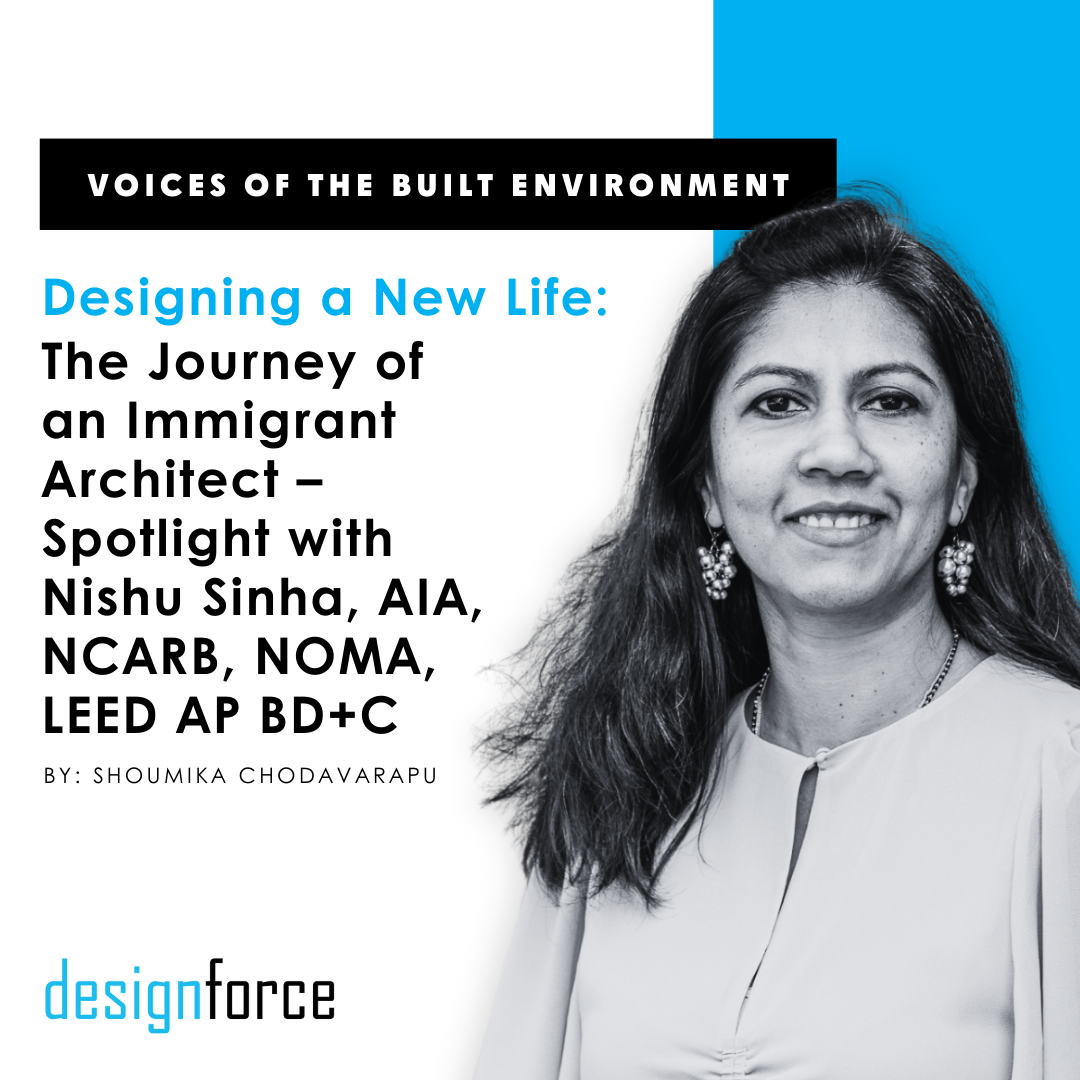
Related Posts
Let's learn together.
Stay inspired and in the know on all things A|E|C.
Sign up for our monthly newsletter.



